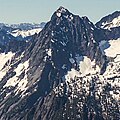| Sperry Peak | |
|---|---|
 North aspect of Sperry Peak | |
| Highest point | |
| Elevation | 6,120 ft (1,865 m) [1] |
| Prominence | 720 ft (219 m) [1] |
| Parent peak | Vesper Peak [2] |
| Isolation | 0.73 mi (1.17 km) [2] |
| Coordinates | 48°00′57″N121°30′09″W / 48.015894°N 121.502633°W [1] |
| Geography | |
 | |
| Interactive map of Sperry Peak | |
| Country | United States |
| State | Washington |
| County | Snohomish |
| Parent range | North Cascades Cascade Range |
| Topo map | USGS Silverton |
| Geology | |
| Rock age | 260 to 370 million years |
| Rock type(s) | metamorphosed sandstone shale, conglomerate [3] |
| Climbing | |
| First ascent | 1927 |
| Easiest route | Scrambling Southwest slope |
Sperry Peak is a 6,120+ ft (1,870+ m) mountain summit in Snohomish County of Washington state.






